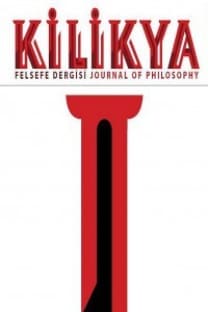Etkileşimci Metafor Kuramının Eleştirisi
Bu yazıda Elisabeth Camp'in metafor kuramını eleştireceğim. Bu kurama göre metaforik anlam metaforik olarak kullanılan terimin işaret ettiği şeyin karakterizasyonunun bir başka şeyin karakterizasyonu ile etkileşimi yoluyla ortaya çıkar. Bu etkileşim beraberinde metaforun önemli bilişsel özelliklerinden biri olan olarak-görme etkisini zorunlu olarak getirir. Ben bu kuramın açıklamaya çalıştığı dilsel olguyu gereksiz yere karmaşıklaştırdığını savunacağım. Söz konusu olgu etkileşime gerek olmadan da açıklanabilir. Camp'in tersine, olarak-görme etkisinin metafor için özsel olmadığını savunacağım. Bunların yanı sıra Camp'in metafor kuramının kimi değillenmiş metafor kullanımlarını açıklayamadığını göstermeye çalışacağım.
Anahtar Kelimeler:
Metafor, etkileşimci metafor kuramı, Elisabeth Camp, değilleme, olarak-görme etkisi
Criticism of the Interactionist Theory of Metaphor
In this paper, I will criticise Elisabeth Camp's theory of metaphor. According to this theory, the metaphorical meaning arises from the interaction of the characterization of the thing which the metaphorically used term indicates with the characterization of another thing. The interaction forces out one of the most important cognitive features of metaphor, the seeing-as effect. I will argue that this theory unnecessarily complicates the linguistic phenomenon it tries to explain, and that the phenomenon in question could be explained without the need for interaction. Contrary to Camp, I will try to show that the seeing-as effect is not essential for metaphor. I will also try to demonstrate that Camp's theory of metaphor fails to explain some uses of negated metaphors
___
- Black, M. (1954-1955). Metaphor. Proceedings of the Aristotelian Society, 55, 273-294.
- Camp, E. (2003). Saying and seeing-as: The linguistic uses and cognitive effects of metaphor (Doktora Tezi). University of California, Berkeley, ABD.
- Camp, E. (2006). Metaphor and that certain ‘je ne sais quoi’. Philosophical Studies, 129(1), 1-25. Doi: 10.1007/s11098-005-3019-5
- Camp, E. (2015). Logical concepts and associative characterizations. E. Margolis & S. Laurence (Ed.), The conceptual mind: New directions in the study of concepts içinde (ss. 591-621). Cambridge, MA: The MIT Press.
- Lycan, W. G. (2008). Philosophy of language: A contemporary introduction (2. baskı). New York, NY: Routledge.
- Cavell, S. (1998). Must we mean what we say? A book of essays. Cambridge: Cambridge University Press.
- Davies, M. (1982-1983). Idiom and metaphor. Proceedings of the Aristotelian Society, New Series, 83(1), 67-86. Doi: 10.1093/aristotelian/83.1.67
- Moran, R. (1989). Seeing and believing: Metaphor, image, and force. Critical Inquiry, 16(1), 87-112. Doi: 10.1086/448527
- Searle, J. R. (1980). The background of meaning. J. R. Searle, F. Kiefer & Manfred Bierwisch (Ed.), Speech act theory and pragmatics içinde (ss. 221-232). Dordrecht, Hollanda, Boston, ABD, Londra, İngiltere: D. Reidel Publishing Company.
- Searle, J. R. (1993). Metaphor. A. Ortony (Ed.), Metaphor and thought (2. baskı) içinde (ss. 83-111). Cambridge: Cambridge University Press.
- Stern, J. (2000). Metaphor in context. Cambridge, MA: The MIT Press.
- Yayın Aralığı: Yılda 2 Sayı
- Başlangıç: 2014
- Yayıncı: Eray Yağanak
Sayıdaki Diğer Makaleler
Etkileşimci Metafor Kuramının Eleştirisi
Felsefenin Doğuşuna İçkin Bir Unsur Olarak Mitos
Gramer Hatalarına Dayalı Argümantasyon ve Bir Ad Hominem Alt Türü Olarak "De Ayrı" Safsatası
Gramer Hatalarına Dayalı Argümantasyon ve Bir Ad Hominem Alt Türü Olarak "De Ayrı" Safsatası
